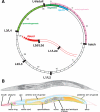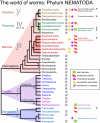Nematodes: the worm and its relatives
- PMID: 21526226
- PMCID: PMC3079589
- DOI: 10.1371/journal.pbio.1001050
Nematodes: the worm and its relatives
Erratum in
- PLoS Biol. 2011 Apr;9(4). doi: 10.1371/annotation/083d39ea-2269-4915-9297-bc6d9a9f7c58
Conflict of interest statement
The author has declared that no competing interests exist.
Figures


References
-
- Maupas E. Modes et formes de reproduction des nematodes. Archives de Zoologie Experimentale et Generale. 1900;8:463–624.
-
- Brenner S. Sydney Brenner and Caenorhabditis elegans. 2010. Caenorhabditis elegans WWW Server. Available: http://elegans.swmed.edu/Sydney.html. Accessed 14 March 2011.
-
- Sulston J. E. Neuronal cell lineages of the nematode Caenorhabditis elegans. Cold Spring Harb Symp Quant Biol. 1985;50:443–452. - PubMed
-
- Sulston J. E, Schierenberg E, White J. G, Thompson J. N. The embryonic cell lineage of the nematode Caenorhabditis elegans. Dev Biol. 1983;100:64–119. - PubMed
MeSH terms
LinkOut - more resources
Full Text Sources

